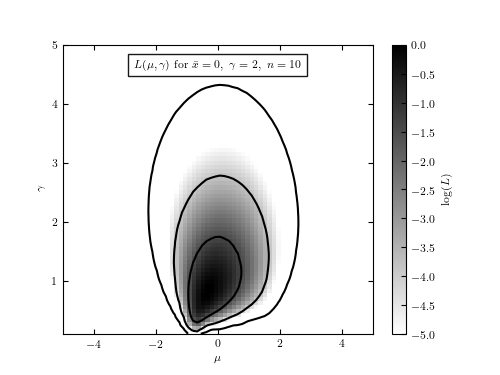Log-likelihood for Cauchy Distribution¶
Figure 5.10
An illustration of the logarithm of posterior probability distribution for
 and
and  ,
,  (see eq. 5.75) for
N = 10 (the sample is generated using the Cauchy distribution with
(see eq. 5.75) for
N = 10 (the sample is generated using the Cauchy distribution with
 and
and  ). The maximum of L is renormalized
to 0, and color coded as shown in the legend. The contours enclose the regions
that contain 0.683, 0.955 and 0.997 of the cumulative (integrated) posterior
probability.
). The maximum of L is renormalized
to 0, and color coded as shown in the legend. The contours enclose the regions
that contain 0.683, 0.955 and 0.997 of the cumulative (integrated) posterior
probability.

mu from likelihood: [-0.36231884]
gamma from likelihood: [0.81014493]
mu from median -0.2625695623133895
gamma from quartiles: 1.10950042396172
# Author: Jake VanderPlas
# License: BSD
# The figure produced by this code is published in the textbook
# "Statistics, Data Mining, and Machine Learning in Astronomy" (2013)
# For more information, see http://astroML.github.com
# To report a bug or issue, use the following forum:
# https://groups.google.com/forum/#!forum/astroml-general
from __future__ import print_function, division
import numpy as np
from matplotlib import pyplot as plt
from scipy.stats import cauchy
from astroML.plotting.mcmc import convert_to_stdev
from astroML.stats import median_sigmaG
#----------------------------------------------------------------------
# This function adjusts matplotlib settings for a uniform feel in the textbook.
# Note that with usetex=True, fonts are rendered with LaTeX. This may
# result in an error if LaTeX is not installed on your system. In that case,
# you can set usetex to False.
if "setup_text_plots" not in globals():
from astroML.plotting import setup_text_plots
setup_text_plots(fontsize=8, usetex=True)
def cauchy_logL(xi, gamma, mu):
"""Equation 5.74: cauchy likelihood"""
xi = np.asarray(xi)
n = xi.size
shape = np.broadcast(gamma, mu).shape
xi = xi.reshape(xi.shape + tuple([1 for s in shape]))
return ((n - 1) * np.log(gamma)
- np.sum(np.log(gamma ** 2 + (xi - mu) ** 2), 0))
#------------------------------------------------------------
# Define the grid and compute logL
gamma = np.linspace(0.1, 5, 70)
mu = np.linspace(-5, 5, 70)
np.random.seed(44)
mu0 = 0
gamma0 = 2
xi = cauchy(mu0, gamma0).rvs(10)
logL = cauchy_logL(xi, gamma[:, np.newaxis], mu)
logL -= logL.max()
#------------------------------------------------------------
# Find the max and print some information
i, j = np.where(logL >= np.max(logL))
print("mu from likelihood:", mu[j])
print("gamma from likelihood:", gamma[i])
print()
med, sigG = median_sigmaG(xi)
print("mu from median", med)
print("gamma from quartiles:", sigG / 1.483) # Equation 3.54
print()
#------------------------------------------------------------
# Plot the results
fig = plt.figure(figsize=(5, 3.75))
plt.imshow(logL, origin='lower', cmap=plt.cm.binary,
extent=(mu[0], mu[-1], gamma[0], gamma[-1]),
aspect='auto')
plt.colorbar().set_label(r'$\log(L)$')
plt.clim(-5, 0)
plt.contour(mu, gamma, convert_to_stdev(logL),
levels=(0.683, 0.955, 0.997),
colors='k')
plt.text(0.5, 0.93,
r'$L(\mu,\gamma)\ \mathrm{for}\ \bar{x}=0,\ \gamma=2,\ n=10$',
bbox=dict(ec='k', fc='w', alpha=0.9),
ha='center', va='center', transform=plt.gca().transAxes)
plt.xlabel(r'$\mu$')
plt.ylabel(r'$\gamma$')
plt.show()
